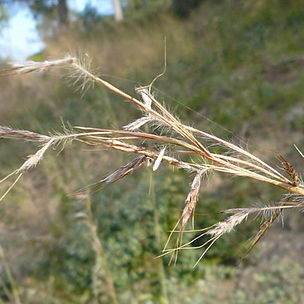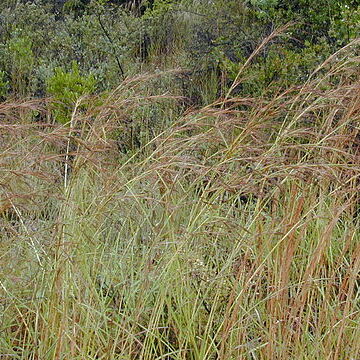Tall annuals or perennials. Leaf-blades linear, never aromatic; ligule scarious. Inflorescence composed of paired racemes, each pair supported on a peduncle and subtended by a sheathing spatheole, the latter crowded into a large leafy false panicle; racemes short, slender, each raceme borne upon a short stalk (raceme-base) which is often deflexed at maturity, and with up to 2 of the lowermost spikelet pairs (homogamous pairs) ♂ or barren, awnless and tardily deciduous; internodes and pedicels linear. Sessile spikelet narrowly lanceolate to lanceolate-oblong, dorsally compressed or terete; callus obtuse to pungent, applied obliquely to the top of the internode with its tip free; lower glume coriaceous, broadly convex across the back and sides, without keels or these developed only in the uppermost third; upper glume awnless; lower floret reduced to a hyaline lemma; upper lemma stipitiform, bidentate, passing between the teeth into a stout awn with pubescent or hirtellous column. Caryopsis oblong, subterete. Pedicelled spikelet ♂ or barren, narrowly lanceolate, usually a little longer than the sessile, awnless or aristulate from the lower glume.
Sessile spikelet narrowly lanceolate to lanceolate-oblong, dorsally compressed or terete; callus obtuse to pungent, applied obliquely to the apex of the internode with its tip free; inferior glume coriaceous, broadly convex across the back and sides, without keels or these developed only in the uppermost third; superior glume awnless; inferior floret reduced to a hyaline lemma; superior lemma stipitiform, bidentate, passing between the teeth into a stout awn with pubescent or hirtellous column.
Spikelets arranged in pairs at the nodes of short paired racemes, each pair sub-tended by a spathe, the lowest pairs alike, awnless, similar to the pedicellate spikelets above; first glume of sessile fertile spikelet flat or rounded, not keeled, or keeled only near the summit; lemma small and narrow, sometimes minutely lobed, with a relatively strong geniculate awn; pedicellate spikelets about as large as the sessile, awnless.
Inflorescence composed of paired racemes, each pair supported on a peduncle and subtended by a sheathing spatheole, the latter crowded together in a large leafy false panicle; racemes short, slender, each borne upon a short stalk (raceme-base) which is often deflexed at maturity, and with up to 2 of the lowermost spikelet pairs (homogamous pairs) male or barren, awnless and tardily deciduous; internodes and pedicels linear.
Pedicelled spikelet male or barren, narrowly lanceolate, usually a little longer than the sessile spikelet, awnless or aristulate from the inferior glume.
Ligule scarious; leaf laminas linear, never aromatic.
Caryopsis oblong, subterete.
Tall annuals or perennials.


